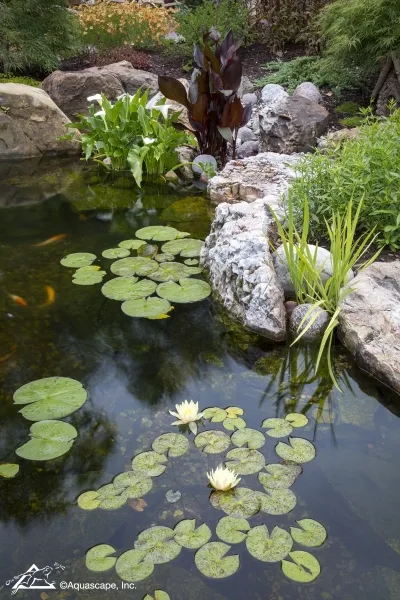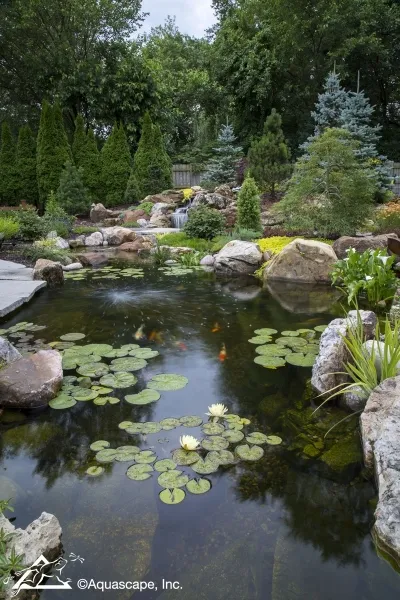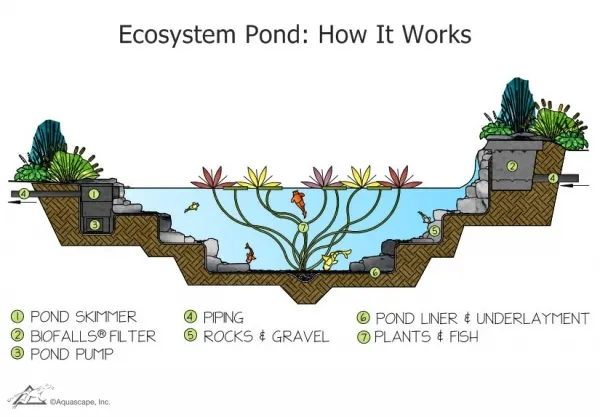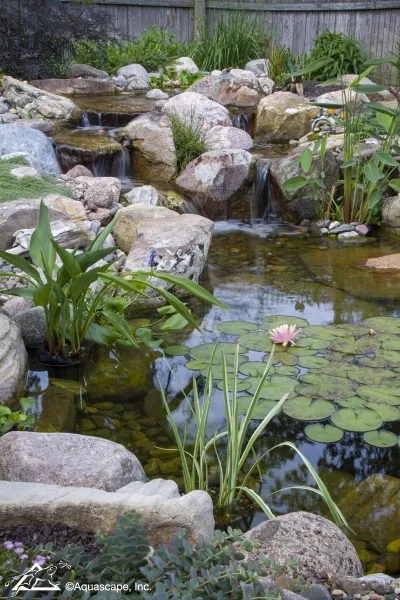- Shop
-
Aquascape Water Features Catalog 2020
- AERATION 60-63
- AQUATIC PLANT CARE 105-106
- BACKYARD WATERFALL LANDSCAPE FOUNTAIN KIT 18-19
- DECORATIVE 107-125
-
FILTRATION 25-41
- AquaBlox® Water Storage Modules
- BIOBALLS BIOLOGICAL FILTER MEDIA
- BIOFALLS FILTERS
- IONGEN SYSTEM G2 & ACCESSORIES
- POND FILTER URN
- POND SKIMMER FILTERS
- PONDLESS WATERFALL VAULT
- SNORKEL AND CENTIPEDE WETLAND FILTER
- ULTRACLEAR UV CLARIFIER
- ULTRAKLEAN POND FILTER KITS
- ULTRAKLEAN POND FILTERS
- WATERFALL SPILLWAY
- FISH CARE 100-104
- INSTALLATION TOOLS 133-135
- LANDSCAPE FOUNTAIN KITS 20-24
- LINER, UNDERLAYMENT, AND GEOTEXTILE 126-128
- PIPE AND PLUMBING 129-132
- POND AND LANDSCAPE LIGHTING 64-73
- Pond Kits 8-12
- PONDLESS WATERFALL KITS 13-17
- POWER 74-75
- PREDATOR CONTROL 94-95
-
PUMPS 42-59
- AquaForce® Solids-Handling & AquaForce® Adjustable Flow Solids-Handling Pond Pumps
- Aquascape EcoWave® Pumps
- Aquascape Ultra Pump Series
- AquascapePRO® POND PUMPS
- AQUASURGE ADJUSTABLE FLOW POND PUMPS
- AQUASURGE POND PUMPS
- Cleanout Pump & Discharge Hose
- PL & PN SOLIDS-HANDLING PND PUMP
- POND POWERHEAD
- SLD ADJUSTABLE FLOW POND PUMPS
- Statuary Water Pumps
- RAINWATER HARVESTING 136-139
- SEASONAL CARE 96-99
- WATER TREATMENTS 76-93
- Atlantic/OASE 2020 Catalog
- Earthtec Product line
- Fish Care / Health
- Fish Food
- Fish Transport
- Fountains
- Irrigation
- Lake & Pond Management
- Lake Fountains & Aerators
- Lighting
- Nets
-
Plumbing / Fittings
- 3 Way Valves SxS
- Ball Valves
- Barb x Barb Ball Valve
- Bottom Drains
- Brass Gate Valves FxF
- Bulkheads
- Cam Locks
- Cap
- Check Valves
- Coupling
- Cross
- Elbow
- Female Adapters
- Fernco PVC Flexible Fittings
- Hose and Tubing
- Insert Adapter
- Male Adapter
- Nipples - Polyethelene
- Nipples - PVC80
- Paddle / Knife Valves
- Piping and Pond Plumbing
- Plugs
- Reducer
- Reducer Bushing
- Socket
- Tee Fittings
- Union
- Wye
- Pond / Pool Skimmers
- Pond / Waterfall & Kits
- Pond Accessories
- Pond Clarifiers / UV Sterilizers
- Pond Construction Products
-
Pond Filter Systems / Filters
- A Gravity Fed Filters
- Aquascape Filters
- Bio Filter Material
- Bio Filter Media
- BioFalls Filter
- Biological Filter
- Carry / CMI / Pump Intake Screen
- Gravity Fed Filters
- Little Giant / Filters , Strainers
- Microbe Lift Media Bag
- OASE Waterfall Filter
- Pond Boss Filter Box
- Pressurized Filters
- ProEco Pressure Filters
- Pump Vaults & Storage Modules
- Savio Waterfall Wells
- Screens / Strainers
- Submerged Filters
- Waterfall Filters
- Pond Kits
- Pond Liner
- Pump Repair Kits & Parts
- Pumps - External
-
Pumps - Submersible
- Aquascape
- Atlantic Pumps
- CMI Pumps
- Danner
- Fountain Pro Pumps
- Leader Pumps
- Little Giant
- Little Giant F Series Wet Rotor Pumps
-
Little Giant / Cal
- Little Giant / Cal Commercial Effluent Pumps
- Little Giant / CAL P-Series Magnetic Drive
- Little Giant / Cal PWM Series Mag Drive Pumps
- Little Giant / Cal Stainless & Bronze Direct Drive Pumps
- Little Giant Aquarium Pumps
- Little Giant Flex Series Pumps
- Little Giant PE Series Direct Drive Pumps
- Little Giant PES Series Magnetic Drive Pumps
- Little Giant WGFP Series Pumps
- Little Giant WGP Series Pumps
- OASE Pumps
- Pond Boss
- Power Flo Fountain Pumps
- ProEco Pumps
- Savio Pumps
- Tsurumi Pumps
- Water Level & Auto Fill
- Water Treatment Products
- Wind Control
- Aquatic Plant Products
- Cleaners
- Air Pumps & Aeration
-
Aquascape Water Features Catalog 2020
- Brands
- Advanced Adhesi..
- Air-o-Lator
- Airmax
- Aladdin
- Alita
- Aqua Control
- AquaBlox
- Aquafinn
- Aquarium Pharm.
- Aquascape
- Aquility System..
- Atlantic
- Atlas
- BioPro
- BioSafe
- Cal Pump
- Carlisle
- CMI
- Coastal Pond
- Costom Molded P..
- Crystal Blue
- Danner
- Earthtec
- Eclectic Inc
- Ecological Labs
- Emperor
- Fernco Inc
- Firestone
- Fountain Pro
- Fresh Culture
- GC Tek
- Hunter
- Jungle
- Kichler
- Leader
- Little Giant
- Loki
- MacCourt
- MARS
- Mashimizu
- Matala
- Melnor
- Microbe Lift
- Nycon
- OASE
- PEM
- Penn Plax
- Pentair
- Performance Pro
- Plantabbs
- Pond Armor
- Pond Boss
- Pond Care
- ProEco
- Radius
- Savio
- Sealoflex
- Spears
- Speck
- Summit
- Sunterra
- Systems IV
- Tetra
- The Power House..
- Todol
- Tsurumi
- York Garden Pro..
- About Us
-
Welcome to our Store!
When Coastal started in the commercial fountain business in 1988, we were based in a 400 square foot office space. Our catalog was the PEM catalog - approximately 1/8\" thick. We are now in our 40,000 square foot warehouse with catalogs from over 350 manufacturers that total over 47 feet thick! We are very proud of this latest project of consolidating these tens of thousand of pages into a readable and usable catalog of the most important products for our market. Our primary goal is to have \"Everything for the Pond that doesn't need to be fed,\" and \"Everything for the Fountain except the water,\” and to have it for you in stock and at the right price. And, if you do not see what you need, remember - this is only a tiny fraction of the entire product line - please call and ask.

-
- Service
-
Shipping
Unless otherwise specified, we ship via UPS, Fedex, or motor freight. Please advise if a delivery address is residential as freight charges may apply.
Shop with Confidence
All returns must be pre-approved by Coastal's Returns Department, and assigned a Return Goods Authorization number prior to being returned to us freight prepaid. A re-stocking fee up to 25% will apply. There is no return on custom fabrication, special orders, or products held over 90 days. Credits will be issued against future purchase only.
-
- Information
- Contact Us




